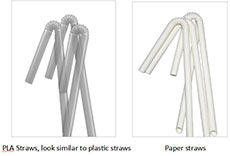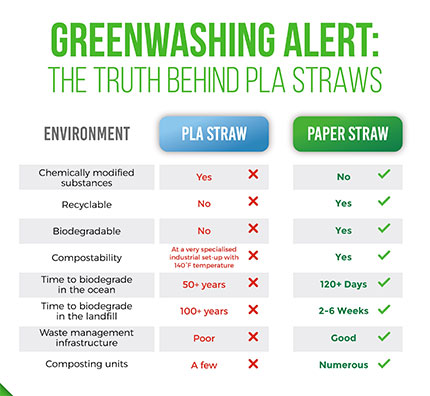In line with the global push to ban single-use plastic, numerous alternatives have been introduced to the market, accompanied by extensive green marketing, aiming to provide sustainable substitutes for plastic. One such product that has gained prominence is the PLA (Polylactic Acid) straw, widely promoted as a greener substitute to conventional plastic straws.
Derived from natural sources such as corn starch or sugarcane, PLA is a perfect imitator of natural plastic. Its adoption in the Indian market gained momentum following the ban on single-use plastic from July 1, 2022. However, a troubling reality persists – some companies are exploiting the eco-conscious movement by engaging in greenwashing practices by promoting PLA straws as a symbol of their commitment to sustainability. This deceptive trend not only misleads consumers but also hampers the genuine efforts toward a greener planet.
PLA straws are often marketed as biodegradable and compostable, emphasizing their origin from renewable resources. Manufacturers claim that these straws break down naturally, reducing the burden on landfills and oceans. The concept is appealing, especially in a country like India, where plastic pollution poses a significant threat to the environment and public health. With this promise, PLA straws have become the go-to choice for beverage brands looking to portray an environmentally responsible image.
The Greenwashing of PLA straws

Greenwashing, the practice of misleading consumers into believing that a company's products are environmentally friendly when they are not, has found a new canvas in PLA straws. Many Indian beverage brands, in their pursuit of profit and positive public perception, engage in tactics that exaggerate the environmental benefits. There are important reasons why PLA straws are not as good for the environment as they seem and are marketed. These reasons are explained below:
1. Non-biodegradable, need specialised industrial composting unit
PLA straws require specific conditions to break down. They must be processed in specialized composting facilities with high temperatures (at least 140°F/60°C) for an extended period (40-65 days) and treated with specific microbes. Unfortunately, India lacks an adequate number of these facilities. This lack of infrastructure results in the improper disposal of PLA straws, ultimately leading them to end up in landfills and oceans.
2. Segregation of PLA straw is a challenge
Separating PLA straws from the general waste stream is crucial, especially given the unknown collection rate of straws in our country. The challenge lies in isolating straws from the larger plastic waste, as effective collection and management of plastics remain central to the ongoing plastic pollution debate in India. Consequently, PLA straws often end up in landfills and oceans due to these challenges, exacerbating environmental issues because of its non-biodegradable nature.
3. Contamination issue and non-recyclable nature of PLA straw
The problem with PLA straws is their inability to be recycled. Although they are compostable, PLA straws have a lower melting temperature, which leads to contamination issues in normal plastic recycling streams. This contamination lowers the quality of recycled plastic, rendering it unsellable and leading to rejection.
4. Methane emission (greenhouse gas) and soil acidification
Disposing of PLA bioplastics in landfills poses a greater risk because, in the absence of oxygen, they emit methane, a greenhouse gas 23 times more potent than carbon dioxide. Studies prove if PLA seeps into the soil, it can acidify the land and deplete essential nutrients vital for crop growth. This could significantly impact crop production in the future.
5. Threats to the marine environment
Straws, being small and lightweight, often find their way into water bodies, making them a substantial portion of beach litter. While paper straws break down easily in marine environments, experts note that PLA straws may take nearly a century to naturally decompose. Paradoxically, this slow decomposition could make the plastic pollution problem even worse instead of making it better.
6. Possible mixing of plastic resigns with PLA
There is also a concerning trend where it has been observed that some straw manufacturers are mixing normal plastic with PLA to produce straws. These mixed straws often find their way into beverage packs, with many brands unknowingly distributing them without proper scrutiny. This kind of malpractice not only raises ethical concerns but also undermines the fundamental purpose of controlling plastic pollution.
Given these limitations, it's evident that PLA straws aren't the right choice and should not be advertised as eco-friendly or biodegradable. Brands must be honest about their impact on the environment and avoid misleading marketing. It is important to understand that not all bio-based products are good for the environment.

Consequences of greenwashingThe consequences of such greenwashing acts by PLA straw manufacturers and brands extend far beyond the mere act of deception. It erodes consumer trust, making it increasingly difficult for the consumer to make informed choices about the products they purchase. When consumers believe they are contributing positively to the environment by choosing PLA straws, they are, in fact, being misled. This disillusionment hampers the genuine efforts to combat plastic pollution, as consumers may become skeptical of all eco-friendly claims, including those backed by legitimate certifications and standards.
Global Initiatives: Phasing out PLA for a sustainable futureCountries around the world are banning single-use plastic products, including those made from bioplastics like PLA, to protect the environment. The EU initiated this transition by banning single-use plastic products in July 2021, covering both traditional plastic and bioplastic items. Following suit, Australia banned these products in early 2022. In the USA, single-use plastic straws made from petroleum or biologically based polymers were banned. New Zealand also announced a phased ban between 2022 and 2025. These global efforts aim to create a sustainable future by curbing the use of single-use plastic, including bioplastic alternatives such as PLA.
How India should respondIndia, in response to global efforts, should proactively work towards reducing its reliance on PLA-based single-use plastics, particularly PLA straws. These straws are often littered, contributing significantly to plastic pollution. Implementing stringent regulations and policies can be instrumental in curbing its usage. The government could introduce comprehensive bans on PLA, following the examples set by the EU, Australia, and New Zealand.
The misleading promotion of PLA straws as eco-friendly alternatives to plastic straws presents a grave environmental threat in India. Comparing this situation to the ban on plastic straws due to their contribution to littering and harmful effect on environment, it becomes evident that PLA straws do not live up to their green claims. Challenges such as inadequate disposal infrastructure, segregation difficulties, contamination problems, greenhouse gas emissions, soli acidification, and slow decomposition rates in both marine and landfills underline the unsustainable nature of PLA straws. To preserve the credibility of eco-friendly efforts and protect the environment, it is crucial for both businesses and Indian policymakers to demonstrate a genuine commitment to sustainability. Following global examples, especially those set by the EU, India should enforce strict regulations to ban PLA straws. Additionally, governments should encourage and incentivise the adoption of genuinely sustainable alternatives such as paper straws.
(The author is working as a research assistant at a leading NGO)